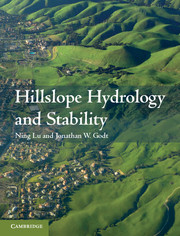Book contents
- Frontmatter
- Contents
- Foreword
- Preface
- List of Symbols
- PART I Introduction and state of the art
- PART II Hillslope hydrology
- Part III Total and effective stress in Hillslopes
- PART IV Hillslope Material properties
- 7 Strength of hillslope materials
- 8 Hydro-mechanical properties
- PART V Hillslope stability
- References
- Index
- Plate section
7 - Strength of hillslope materials
from PART IV - Hillslope Material properties
Published online by Cambridge University Press: 05 February 2013
- Frontmatter
- Contents
- Foreword
- Preface
- List of Symbols
- PART I Introduction and state of the art
- PART II Hillslope hydrology
- Part III Total and effective stress in Hillslopes
- PART IV Hillslope Material properties
- 7 Strength of hillslope materials
- 8 Hydro-mechanical properties
- PART V Hillslope stability
- References
- Index
- Plate section
Summary
Definition of strength
The failure of hillslope materials refers to the abrupt and irreversible downward and outward movement of the surficial soil and rock on a hillside. However, a consensus analytic criterion describing the failure of hillslope materials is not available. Stress and strength concepts are used to define the failure state, as are stress and/or strain, rate of stress/strain and associated strength parameters. Furthermore, the definition of the strength of hillslope materials varies widely dependent on the discipline and perspective. The strength of hillslope materials, as summarized by Selby (1993), has been defined in three general ways: (1) the ability of materials to resist deformation by compressive, tensile, or shear stresses, (2) the ability of materials to resist abrasion, and (3) the ability of materials to resist being transported by a fluid. In soil mechanics, strain is often included as an additional variable that is used to define the strength of soils, such as in the application of kinematics-based limit analysis (e.g., Chen, 1975; Michalowski, 1995) or analyses within the framework of critical state soil mechanics (e.g., Schofield and Wroth, 1968). In this book, strength refers to the ability of hillslope materials to resist strain that arises from the three common modes of tensile, compressional, and shear stresses, or by combinations of any two of these modes.
A simple experiment to measure the strength of cohesive porous materials is a uniaxial compression test. As shown in Figure 7.1, a principal maximum stress is applied in the vertical direction to a cylindrical soil specimen while no stress is applied in the horizontal direction. The state of stress can be illustrated in the shear stress-normal stress plane shown as broken circles in Figure 7.1. Failure, commonly marked by the development of cracks or shear bands, occurs when the applied stress reaches a certain level defined as the uniaxial compressive yield strength, shown in Figure 7.1 as a solid circle. The magnitude of the uniaxial strength of hillslope materials can vary from zero for dry and non-cohesive sandy soil to several thousand kPa for dry and overly consolidated clay or cemented sands. The direction of the failure plane is characteristically along 45° + ϕ∕2, where ϕ is called the internal friction angle and will be discussed further in this section.
- Type
- Chapter
- Information
- Hillslope Hydrology and Stability , pp. 247 - 281Publisher: Cambridge University PressPrint publication year: 2013



